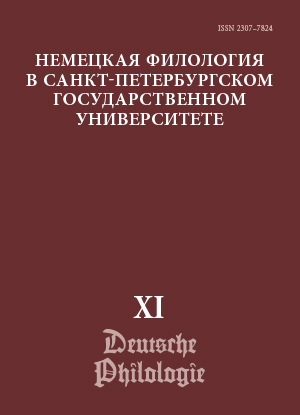Ethnolinguistic specificity of German conventional similes with an onym component against the background of the Russian language
Abstract
Conventional similes represent a system of paragon images. This paper is focused on the ethnolinguistic specificity of German conventional similes containing onyms. The research is conducted with an account of the links between linguistic and cultural phenomena. Authors explore German conventional similes with onyms (anthroponyms and ethnonyms) against the background of the Russian language. At the moment of ontological entering into a conventional simile, the ethnolinguistic specificity of anthroponyms and ethnonyms is mediated by linguocultural concepts. From the category of proper names with an assigned stereotypisation, the both classes of onyms move into the realm of metaphors, already as components of a stock phrase. As part of conventional similes, onyms go through the processes of desemantisation and deonymisation. To analyse conventional similes, we use component analysis and the linguocultural method. The morphosyntactic structure of German conventional similes corresponds to the “[X] wie/als [Y]” model. These are replicable phrases, with their phraseological specificity being based on the logical operation of a coupled comparison. The invariant comparison model includes three components of the logical comparison formula: the comparison object, the comparison basis (tertium comparationis), and the comparison standard. The object is compared to another object by means of the cognitive operation of associative assimilation through the comparison basis, with the connectors wie, als being included. Our research conducted to using the linguoculturological method has shown that, out of the three components of comparison, both the comparison standard and the comparison basis demonstrate ethnolinguistic specificity. In German conventional similes, anthroponyms with the simplex structure “one-component personal name” are a frequently used model. German conventional similes include anthroponyms with a rich ethnolinguistic specificity represented by biblicisms, Italian, Greek and Germanic onyms. Ethnic stereotypes, reflected in the semantics of the comparison basis and comparison standards, provide background for emotional evaluative nomination of human qualities, mainly the negative ones. In both languages, ethnonyms in a conventional simile are a means of implementing the discourse practice of ‘friend or foe’ identification through ethnic stereotypes formed as a result of various kinds of linguo-geographic contacts.
Keywords:
onomastics, onym, phraseology, conventional simile, ethnolinguistic specificity, German language, Russian language
Downloads
References
References
Downloads
Published
How to Cite
Issue
Section
License
Условия передачи авторских прав на статьи и рецензии, опубликованные в ежегодном периодическом издании «Немецкая филология» регулируются условиями Лицензионного Договора автора с Санкт-Петербургским государственным университетом. В соответствии с Лицензионным Договором опубликованные материалы находятся в открытом доступе, а авторам бесплатно предоставляется неограниченные возможности их распространения и самостоятельного архивирования.




